Saturday, June 29, 2013
Tack!!!
Thursday, June 27, 2013
the answer!
To the last blog I showed a strange picture of a black horse, with an English saddle with boots in backwards. This is the riderless horse. no..... its not a horror story. It is the highest tribute any military person can have. This horse often appears at funerals, and parades.
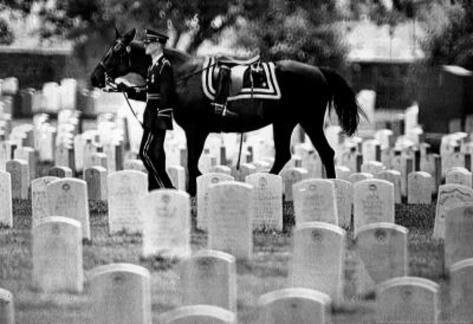

this horse was the riderless horse for Ronald Regan. The first president to have a riderless horse at his funeral was Abraham Lincoln. This horse is only for the marines, and the army, but only for colonel and above. Although the exceptions are the President, by virtue of having been the country's commander in chief and the Secretary of Defense, having overseen the armed forces.
The boots are reversed in the stirrups to represent a fallen leader looking back on his troops for the last time.

Tack: At traditional funerals the tack tends to be: any English type of saddle, black or/and white, boots of the fallen, and a bridle.
But at parades, the horse can wear a western saddle, halter, and any conservative saddle pad.
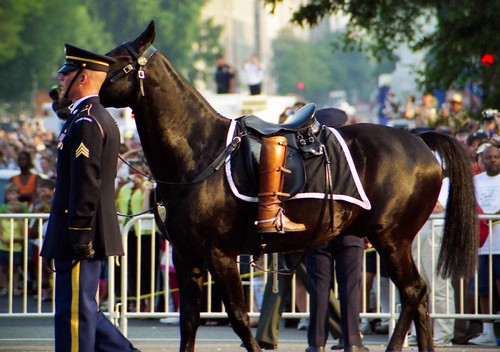

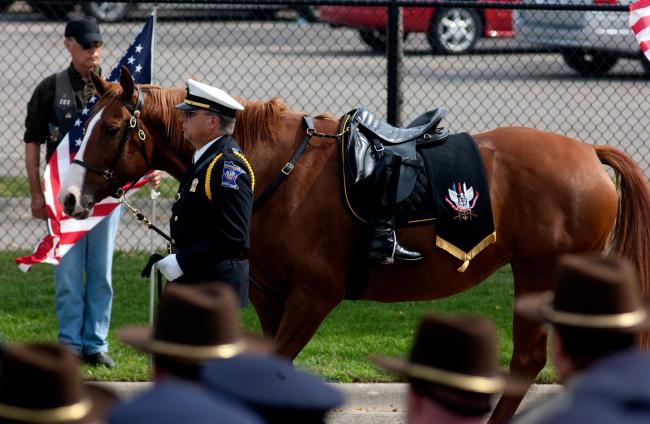
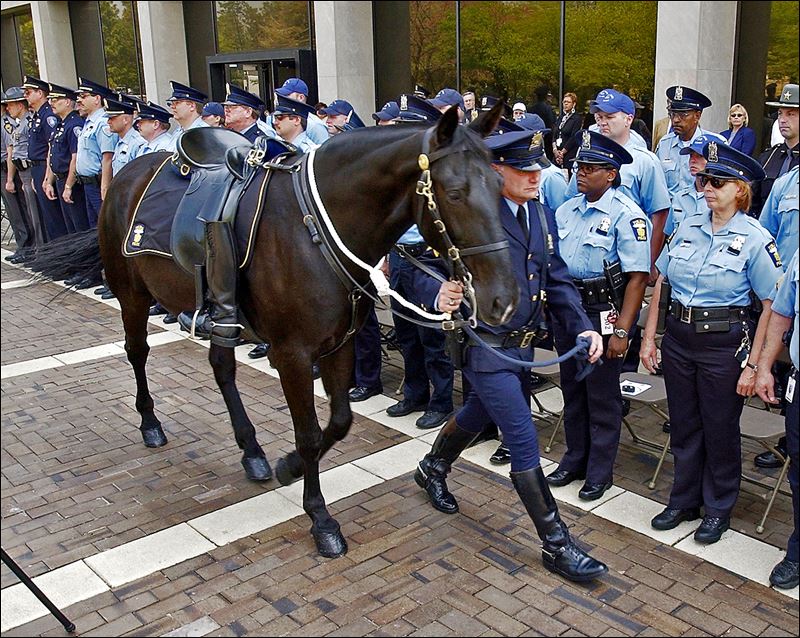
Horse: At traditional funerals the horse is always black. But during parades, the horse can be any color under the sun.
These horses are always treated with the utmost respect. People stand and will either salute, stand, or have their hand over their heart.
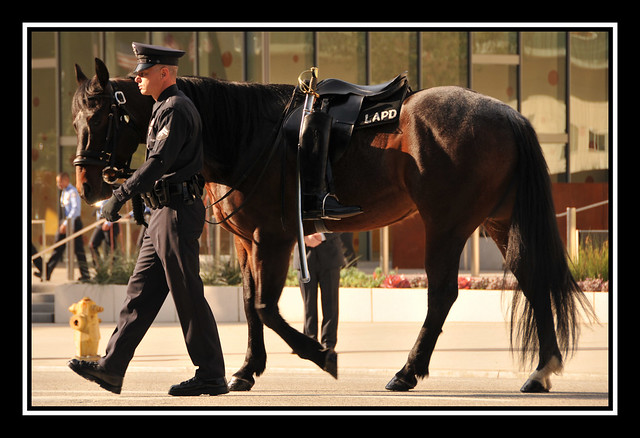


this horse was the riderless horse for Ronald Regan. The first president to have a riderless horse at his funeral was Abraham Lincoln. This horse is only for the marines, and the army, but only for colonel and above. Although the exceptions are the President, by virtue of having been the country's commander in chief and the Secretary of Defense, having overseen the armed forces.
The boots are reversed in the stirrups to represent a fallen leader looking back on his troops for the last time.

Tack: At traditional funerals the tack tends to be: any English type of saddle, black or/and white, boots of the fallen, and a bridle.
But at parades, the horse can wear a western saddle, halter, and any conservative saddle pad.




Horse: At traditional funerals the horse is always black. But during parades, the horse can be any color under the sun.
These horses are always treated with the utmost respect. People stand and will either salute, stand, or have their hand over their heart.

Wednesday, June 26, 2013
Tuesday, June 25, 2013
Friday, June 21, 2013
ugh!
So due to my excessive laziness, I have not started anything new. I am still weaving the saddle pad, and am still saving up for a parade saddle. My too do list is :
http://www.youtube.com/watch?v=emxI-nRGWBE
and last, my horse going nuts!
http://www.youtube.com/watch?v=3q51gp5y6_0&list=UUpNZBh3HK1jj0Pn1uZJpuQQ
- finish saddle pad
- work on photo shows
- clean desk
- pick up horses
- create a pack saddle set (Unknown horse)
- create a pacer set
- make braided western reins
http://www.youtube.com/watch?v=emxI-nRGWBE
and last, my horse going nuts!
http://www.youtube.com/watch?v=3q51gp5y6_0&list=UUpNZBh3HK1jj0Pn1uZJpuQQ
Monday, June 17, 2013
Saddle pads
The cross stitch pads and I did not get along so I'm weaving my next. Later on I will do a post on how to weave.
Wednesday, June 12, 2013
Australian Riding
 |
| bella waiting to be bridled, this is the tack up area for our barn. there are two sets of cross ties. |
This post is all about the Australian riding style. My hands are not the greatest and my stirrups are not on the ball of my foot. But for dolls keep in mind, the pollys (Knee pad) are to be parallel to your thigh. 1/4 of your weight should be on your feet. I was told if you feel the over girth you are not sitting right. You want to sit more of in a chair position than most saddles.
he Australian Stock Saddle is a saddle in popular use all over the world for activities that require long hours in the saddle and a secure seat. The saddle is suitable for cattle work, starting young horses, everyday pleasure riding, trail riding, endurance riding, polocrosse and is also used in Australian campdrafting competitions and stockman challenges.The traditional Australian stock saddle was designed for security and comfort in the saddle no matter how harsh the conditions. While having stylistic roots from the English saddle in the design of the seat, panels, fenders, and stirrups, it has a much deeper seat, higher cantle, andknee pads in the front to create a very secure saddle for riders who ride in rough conditions or spend long hours on a horse.The saddle is kept on with a girth attached to billets under the flaps, similar to those on a dressage saddle. A surcingle passing over the seat of the saddle is also used toprovide additional safety. The rear of the saddle is sometimes secured by a crupper. A breastcollar is sometimes added. A saddle blanket or numnah is used under the saddle to absorb sweat and to protect the back of the horse.
History
Initially the stock saddle was a "park" style saddle similar to the modern English showing saddle, with low set knee rolls and short flaps. However, this style of saddle did not suit the rugged Australian terrain and did little protect the rider’s legs from sweat. Thus the flaps were lengthened, thigh and knee pads added, the seat deepened and the cantle raised. A saddlemaker named Jack Wieneke developed a design that was popular for a number of years, but the design over time became too extreme and lost favour to more conservative styles.During the early days of buckjumping in Australian rodeos, riders rode in a modified stock saddle using a crupper instead of the "flank cinch" used in the USA. Ladies stock saddles were traditionally made with a pigskin seat and with longer, pigskin covered knee and thigh pads.Current design
Modern styles range from traditional models through to a newer "half breed" that incorporates the independent swinging fender and stirrup style of the western saddle with the traditional Australian tree and seat style. There are also "cross breed" saddles that combine other western saddle elements, such as a saddle horn or a western cantle design, with traditional Australian elements, such as the pommel swells and deep seat.Comparison with other styles
The Australian Saddle combines some features of both English and Western saddles. The Aussie saddle allows riders to be able to move with the horse over difficult terrain. The added “knee pads” help to keep the rider in the saddle, as do the high cantle and pommel. The stirrup position on the Aussie saddle is a little more forward than in a western saddle and the seat positions the legs in front of the body. This makes the saddle comfortable for long hours of riding and for riding in tough terrain. One of the issues with the Australian stock saddle is thestirrup leathers , as the leathers lie on the outside of the flap and against the leg. if not wide enough, the leg can get pinched. Some new designs, such as the "swinging fender", that incorporates the western-style stirrup leather, have attempted to address this issue. Some saddles, particularly some designs sold in the United States also add a western-style saddle horn, though this is not a traditional element of the Australian saddle.
 |
| Walking |

Walking
Trot/ Jog
Canter
Canter
Canter
Canter
jog/ trot
Australian seat position
Cantering
cantering
dressage collected trot
running to her friends!
you can spot all four hoof bottoms in this picture! Who can tell me how many shoes my girl has?
Galloping
Searching
more searching
even more searching
full gallop
found 'em!
Sunday, June 9, 2013
Saddles
What should I take photos of? I was thinking it would be helpful to take photos of my saddles. I have four different saddles. My Australian saddle (stock style with tooling and lots of rings), my synthetic wintec dressage saddle, my collegiate all purpose saddle, or my western saddle? The hardest thing is finding someone with a horse and saddles but I own all these saddles and can take many photos. Any requests? Any specific areas?
Friday, June 7, 2013
Cat update
Last week I was asked by a fellow boarder at my horse barn to see if I recognized a new cat. I went to go look where she was which was in the corner of the arena and I had never seen the cat before. I noticed she didn't look good and she wasn't moving at all. I went to ride to see if she would move and she didn't at all. After I was done riding I went for the cat. I took her to the sink and gave her a bath to remove the sand and bird debris in her long hair coat. After the bath I offered her food and shaved the worst mats out of her coat. She took some but was so weak she couldn't lift her head. (picture 1).
I brought her home and due to the possibility of feline leukemia and FIV I was only allowed to keep her In my garage in a dog crate. I took the cat to my neighbors house (she works at a vet school) and we found out she was in shock and extremely dehydrated. I offered food and water and set her in the crate for bed. (picture 2)

The next day I decided I was gonna get rid of most of the mats that claimed her coat and shaved some areas down. I also found that she was declawed and obviously was a house pet. I took her to the vet to see if she had a microchip and what gender. We found her to not have any ID and was a spayed female. I also had the chance to weigh her and she weighed a mighty 6.4 pounds. She should be over 10 pounds.
After a day or so of never seeing this boney cat eat I pulled out a syringe and started force feeding and we scheduled a visit to the vet. A day before the vet she started eating on her own. We were now getting concerned because she hasnt used the restroom for 7 days +. But the stress of the vet made her start moving again. We left the vet that day with negative feline leukemia/ FIV test, negative worms test, a dewormer tablet, and a stool softner. The picture is of her waiting for her test results
That night she was moved to my restroom for a larger space and we added a litter box. She ended up getting stuff stuck In her tail making her uncomfortable, stinking up the room, and creating a mess. So I shaved her tail partly.
This morning I noticed some blood and I was also waiting for another blood tests result. I also saw she was refusing food again. This blood test showed she was animic, and had some sort of infection. And for the eatting I was given perscription cat food, and two antibiotics. By the time before I wrote this, she started eating and drinking all by herself and she even used the litter box. Her name is Hope and will be going to a new permanent home on Tuesday, only because I'm very allergic. Now for a funny face of my dog!
Subscribe to:
Posts (Atom)































.jpg)







